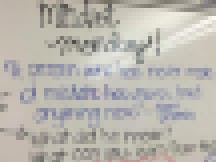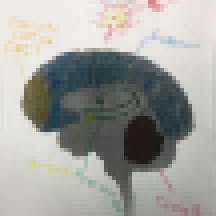Last school year, I made drastic changes in my classroom management system.
Due to a schoolwide initiative, my behavior “clip chart” system ended, and in turn, school rules were replaced with a language that promoted growth mindset. I was determined to epitomize this with my students and end hearing the dreaded, “I can’t do this”-esque language that can sometimes plague a lesson or project. I was on a mission to change the way students speak with themselves.
The growth mindset isn’t anything new—people have been writing about it more frequently for the last few years. But just because it’s popular doesn’t mean it’s easy to create a pathway for students to embrace struggle and realize that their hard work and effort can actually help them become smarter.
Here’s the issue: my biggest challenge was how I was going to teach my third grade students to develop a growth mindset. I knew there were changes I had to make, including modeling growth mindset myself. This meant accepting my mistakes, openly and visibly, in front of my class. This also meant changing my praise from, “Wow, you are so smart!” to, “I can tell you worked hard on that assignment!” I knew I had to openly set goals for myself (with my class), and worked to achieve them all week (with the support of my class). These personal goals ranged from organization skills to developing stronger relationships with my students.
But as time went on, something else become apparent: you can teach growth mindset across multiple subjects, but there’s a number of ways to creatively incorporate it into each subject matter. Throughout the year I observed my students blossoming, accepting not only their mistakes, but the mistakes of others graciously. To foster a culture of growth mindset, I combined both explicit and implicit teaching through literature, science and history—and list technologies that I’ve used to push growth mindset even further.

Literature: Analyzing Character Traits and Empathizing With Their Struggles
There are several children’s picture books and young adult chapter books that can be used to address perseverance, overcoming obstacles, and learning the subliminal beauty of mistakes. Specifically, in my classroom, we use the texts to analyze character traits and character motivation, and to discuss how characters’ actions affect outcomes. Fish in a Tree by Lynda Mullaly Hunt, for example, is an engaging text that addresses the learning differences of students and how decisions and character can affect the outcome of a situation.
Students can use the Book Creator App to showcase these traits. Within the app, students can create an ongoing book throughout the year to showcase characters who exhibit growth mindset. Or, if you’re into group projects, another option would be to create a class book, with each student highlighting their own example of characters who display growth mindset from their independent reading.
You can also use books such as The Most Magnificent Thing by Ashley Spires as a platform for goal setting. Throughout this text, the protagonist struggles to create a “magnificent thing” with idea after idea failing. Students can set their own individual and class goals and manage their progress using digital tools such as Seesaw, which is a K-12 student-driven portfolio. Students are able to take pictures of their work and upload it to their digital portfolio. From there, the work can be shared with their teachers and parents.
Other texts to consider throughout the year, specifically aligned to grades K through 6, are listed below. Cause/effect, problem/solution, and character development are all key elements to consider when analyzing growth mindset. Use Padlet as an ongoing reflection throughout the year for students to compare and contrast how all characters do or do not demonstrate a growth mindset. Provide students with the opportunity to discuss through student-led literature circles.
- Thank You, Mr. Falker by Patricia Polacco
- The Girl Who Never Made Mistakes by Gary Rubenstein
- A Long Walk to the Water by Linda Sue Park
- Hatchet by Gary Paulsen
- The Dot by Peter H. Reynolds
Have more text ideas? Please share in the comments!
Science: Understanding the “How” and “Why” of Brain Development
The foundation of Carol Dweck’s research on growth mindset stems from neuroscience and research on the brain—and introducing students to the science behind it is a great way to get them involved!
Texts such as My Fantastic Elastic Brainby by JoAnn M. Deak (with corresponding app) take the science and adapt it to a student-friendly language. When students understand the “how” behind the “why,” the connection to developing a growth mindset grows deeper.

To engage students further in the science behind growth mindset, students can complete their own brain research. My third grade students this year completed brain maps (shown above), learned how neurons connect to each other, and completed self-assessments about their own mindset.
Not sure where to start? Mindset Works has several free resources to help you get started, which you can access here.
History: Learning From Famous Diplomats and Sports Players
Did you know that Michael Jordan did not make his high school baseball team, or that Steve Jobs was once fired from Apple? Those names are just a few in the pool of “famous failures”—and in this case, the “failure” part is more important than the “famous” part. Acknowledging that failure came before success serves as a reminder for students that we all have the potential to be become better.
Students can research these celebrities and create their own multimedia biography projects through iMovie or augmented reality apps such as Aurasma. Ensure that part of the project requirements are to showcase how their individual demonstrated a fixed or growth mindset, and how, in turn, that was relative to their success (or lack thereof). I continually find that students are amazed to learn that these successful individuals did not get to that point in their careers overnight.
Near the end of the year, I wrote this Albert Einstein quote on our whiteboard: “A person who has never made mistakes has never tried anything new.” I asked my third graders to explain what they thought Einstein meant or what they could take away from his words. One student commented, “I think he means that you can learn from your mistakes. I can learn, [and] if you try something new, and you make a mistake, you are learning.”
That is something anyone can help students understand—in any subject, and in any grade level.


